How to grow Alliums? - The ultimate growing guide for Alliums
Whether you're a seasoned gardener or just starting, this blog will equip you with the knowledge and tips you need to successfully grow Alliums. From planting to maintenance, we'll cover it all, ensuring your Alliums thrive and add charm to your garden. Read on to discover the secrets of nurturing these versatile and striking plants.
Care tips for blooming Alliums
To ensure your blooming Alliums thrive, start by planting them in well-drained soil with full sun exposure. These striking ornamental onion bulbs prefer soil with good drainage to prevent rot. When planting, place them at a depth of 3-4 times the height of the bulb and space them adequately to allow air circulation. Water moderately, keeping the soil consistently moist but not waterlogged during their growing season. Apply a balanced fertilizer in spring to support healthy growth. Deadhead spent flowers to encourage continuous blooming and prevent self-seeding. Alliums are generally low-maintenance and resistant to pests, making them a delightful addition to any garden.
For more detailed information on maintaining your plants, check out our guide on how to care for alliums.
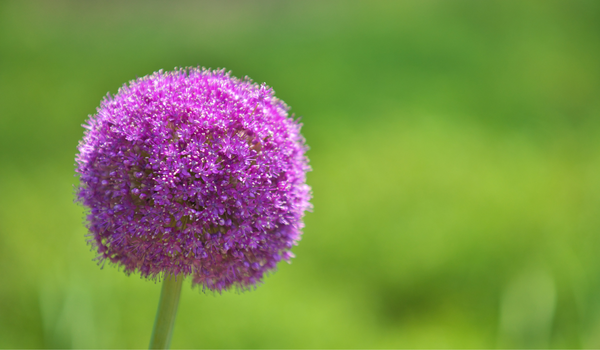
Allium bloom period: what to expect
Alliums usually start blooming in late spring to early summer. That means you'll start seeing their beautiful flowers around April, and they can stick around until June. But keep in mind that the exact blooming time can vary depending on the specific type of Allium and the conditions in your garden. If you want your garden to look colorful for a longer time, you can plant different kinds of Alliums because they might bloom at slightly different times during the spring and early summer.
Ensuring continuous blooms of Alliums
To ensure your Alliums continue to bloom beautifully, plant them in well-draining soil with plenty of sunlight. Allium bulbs should be placed about 3-4 inches deep and spaced apart adequately. Water them consistently, keeping the soil moist but not waterlogged, especially during the growing season in spring and early summer. Applying a balanced fertilizer in the spring can also boost their growth. Deadhead spent flowers promptly to encourage more blooms and prevent self-seeding. Additionally, consider planting companion flowers that bloom at different times, providing continuous color in your garden. Remember, Alliums are generally low-maintenance, so with a little care, they'll grace your garden with their stunning blooms year after year.
The importance of deadheading Alliums
Deadheading Alliums, which are popular flowering bulbs, is generally recommended for maintaining their appearance and promoting better bulb health. Removing spent flower heads, once they have withered and lost their color, prevents the plant from expending energy on seed production. This energy can then be redirected into bulb development, resulting in larger, more robust bulbs for the following year. Additionally, deadheading enhances the overall aesthetic of your garden, ensuring a neat and tidy appearance. However, if you're interested in saving seeds or encouraging self-seeding, you may choose to leave some spent Allium flowers in place. So, whether or not to deadhead your Alliums depends on your specific gardening goals and preferences.
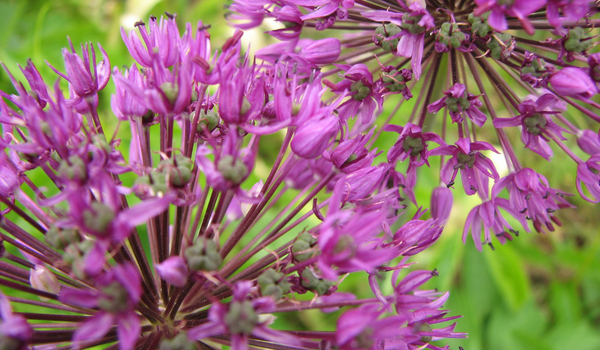
Duration of Allium blooms: a timeline
Once Alliums bloom, their vibrant, globe-shaped flowers typically last for about 3 to 4 weeks, adding a burst of color and elegance to your garden. This period can vary slightly depending on factors like the specific Allium variety, local climate, and soil conditions. To enjoy their beauty for as long as possible, consider planting a mix of early, mid, and late-blooming Alliums. This strategic planting ensures a continuous display of blooms throughout the spring and early summer. With proper care, such as regular watering and suitable soil, you can maximize the lifespan of your Allium blooms and create a stunning, long-lasting garden display.
Multiplying Alliums
These hardy and low-maintenance plants have a remarkable ability to multiply and naturalize over time. When you plant a single allium bulb, it will typically produce a cluster of smaller bulbs or offsets around the original bulb, creating a striking display of multiple blooms. This natural multiplication means that your alliums will gradually spread and cover more ground, enhancing your garden's beauty. To ensure successful multiplication, plant allium bulbs in well-drained soil, provide adequate sunlight, and allow the foliage to die back naturally after blooming to nourish the bulbs for future growth. With proper care, your alliums will continue to multiply, delighting you with their charming blossoms year after year.
Optimal conditions for growing Alliums
To grow beautiful Alliums, start by selecting a sunny spot in your garden with well-draining soil. These striking flowers thrive in full sunlight. Plant the bulbs in the fall, about 3-6 inches deep, with the pointed end facing upwards, and space them 6-8 inches apart. Remember to water them moderately after planting. Alliums don't require excessive watering. Come spring, as they bloom, provide occasional deep watering to keep the soil slightly moist, but avoid overwatering to prevent rot. Apply a balanced fertilizer in early spring to promote healthy growth. Enjoy the stunning, globe-like blooms of your Alliums and watch them attract pollinators to your garden!
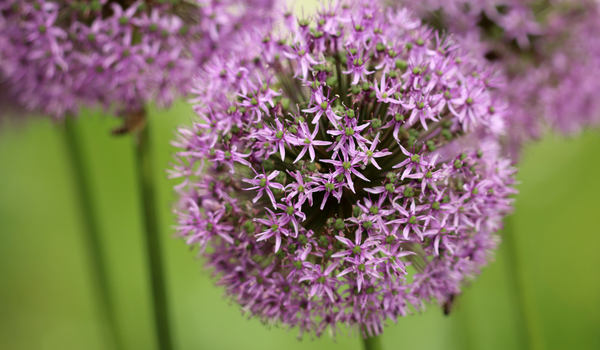
Choosing the right potting soil for flower bulbs
The best potting soil for your flower bulbs is a well-balanced mix that provides essential nutrients and good drainage. Look for a potting soil labeled 'well-draining' to prevent bulb rot and ensure healthy root development. A blend with organic matter, such as compost or peat moss, enhances moisture retention and nutrient availability. It's vital to choose soil specifically designed for bulbs, as it will have the right pH level to support bulb growth. Additionally, consider a mix with perlite or vermiculite to improve aeration.
Tips for faster blooms
To accelerate the growth of your Alliums and enjoy their charming blooms sooner, follow these simple steps.
- First, select a sunny spot in your garden with well-draining soil, as Alliums thrive in sunlight and dislike soggy roots.
- Next, plant your bulbs in the fall, ideally a few weeks before the first frost, placing them about 3-4 inches deep and spaced around 6-8 inches apart.
- Ensure your Alliums receive adequate water, especially during their growth and bloom periods.
- Applying a balanced fertilizer in the spring can also boost growth.
- Lastly, remove spent flowers to encourage more growth and wait patiently for the vibrant Alliums to flourish!
Planting Allium bulbs in Spring
While fall is the preferred planting time for most bulbs, you can still enjoy these vibrant blooms by planting them in the spring. Here's how: choose a sunny location with well-draining soil. Dig a hole about 3 times the depth of the bulb, place it with the pointed end up, and cover it with soil. Water thoroughly. Keep in mind, that spring-planted Alliums may not bloom as fine in their first year, it is even possible they start blooming in Fall.
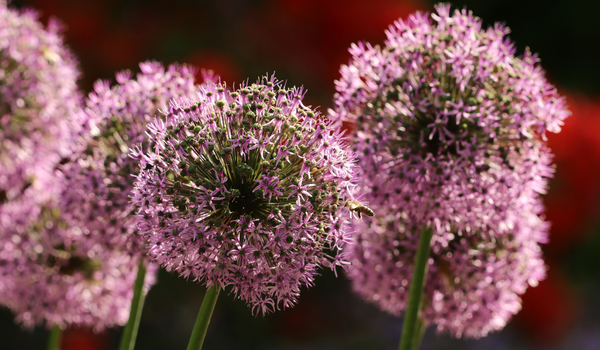
How long do Alliums take to grow from bulb?
Alliums typically take about 10 to 12 weeks to sprout from their bulbs after planting. These flower bulbs are quite low-maintenance. To help them along, plant these bulbs in well-draining soil, provide adequate sunlight, and make sure to water them consistently. Remember, patience is key in gardening, but the reward of those beautiful Allium blooms is absolutely worth the wait!
Number of blooms from one Allium bulb
When you plant a single Allium bulb, it typically produces one striking flower with multiple smaller florets, creating a beautiful, globe-like bloom. As the years go by, these bulbs can multiply, gradually increasing the number of Alliums in your garden, adding to the charm of your floral display.
First-year blooms: Alliums' debut
Alliums typically bloom in their first year after planting. These hardy bulbs are known for their ability to produce stunning spherical flower heads that add a burst of color and texture to your garden. When you plant Allium bulbs in the fall, they establish strong root systems over the winter months, preparing them for a splendid spring display. Depending on the specific Allium variety and growing conditions, you can expect their blooms to emerge in late spring to early summer, creating a captivating focal point in your garden.
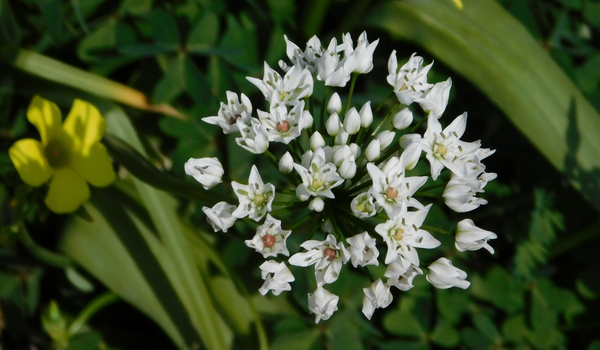
Do Allium bulbs get bigger every year?
They typically increase in size each year when provided with the right growing conditions. These hardy perennial bulbs exhibit a natural tendency to multiply and grow larger over time, resulting in more robust and eye-catching blooms. To encourage this growth, it's essential to plant Allium bulbs in well-draining soil with ample sunlight. Proper spacing between bulbs also allows for adequate airflow and prevents overcrowding, which can hinder their expansion. Regular fertilization and occasional division of mature clumps can further promote their size and vitality, ensuring a stunning display of Allium flowers in your garden year after year.
For a detailed step-by-step guide on planting, check out our article on how to plant alliums. If you're ready to plant your own stunning alliums, check out our allium bulbs for sale to get started.
Share
